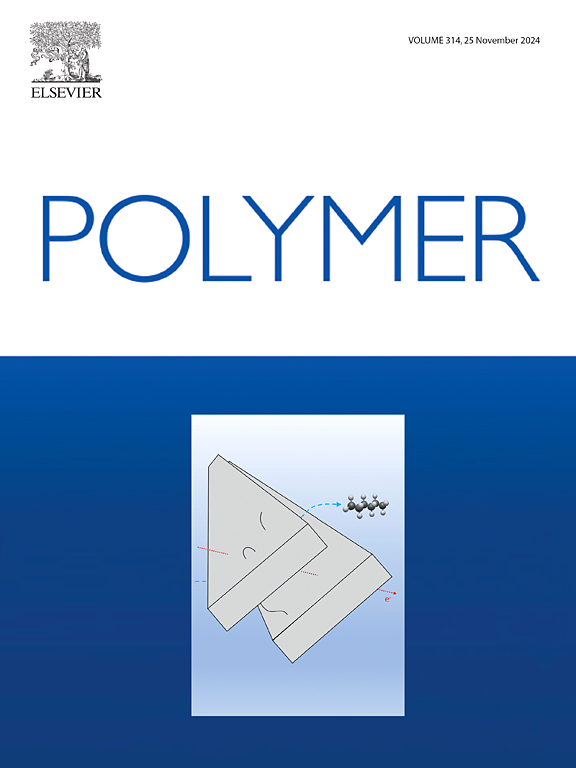Aging behavior, mechanism and lifetime prediction of liquid crystal polymer films under thermal and oxidative conditions for 5G communication applications
IF 4.5
2区 化学
Q2 POLYMER SCIENCE
引用次数: 0
Abstract
Liquid crystal polymer (LCP) materials have emerged as a promising solution for 5G communication applications owing to their exceptional properties and suitability for high-frequency applications. However, the utilization of LCP materials is accompanied by challenges related to aging-induced quality, necessitating extensive research on aging mechanisms and mitigation strategies to ensure sustained reliability and performance in the face of harsh operating conditions and prolonged service life. To address this issue, LCP films were successfully prepared using the blow molding technique. Subsequently, a comprehensive investigation was conducted to explore the aging behavior, predict the lifetime, and understand the underlying aging mechanism of these films under thermal and oxidative conditions. The results indicate that the LCP film maintains a high level of functionality for up to 36 years at 100 °C, 11 years at 120 °C, and 2 years at 150 °C, based on the failure criterion of the dielectric loss factor (Df). The simultaneous occurrence of physics aging and chemical aging, including the relaxation process of main chains, thermal decomposition, Fries rearrangement reactions, and cross-linking reactions, contribute to the aging of the LCP film. Moreover, a specific fluorescence recognition strategy was used to monitor the aging state, providing a promising approach to elucidate the aging behavior of LCP films. These findings offer valuable insights into the development of flexible printed circuit (FPC) material, which are of utmost importance in realizing low-loss and high-speed 5G communication technology.

5G通信中热氧化条件下液晶聚合物薄膜的老化行为、机理及寿命预测
液晶聚合物(LCP)材料由于其卓越的性能和对高频应用的适用性,已成为5G通信应用的有前途的解决方案。然而,LCP材料的使用伴随着与老化质量相关的挑战,需要对老化机制和减缓策略进行广泛研究,以确保在恶劣的操作条件和延长的使用寿命下保持可靠性和性能。为了解决这一问题,采用吹塑技术成功制备了LCP薄膜。随后,对这些薄膜在热氧化条件下的老化行为进行了全面的研究,预测了其寿命,并了解了其潜在的老化机制。结果表明,基于介质损耗因子(Df)的失效准则,LCP膜在100°C下可保持高水平的功能长达36年,在120°C下可保持11年,在150°C下可保持2年。物理老化和化学老化同时发生,包括主链弛豫过程、热分解、Fries重排反应、交联反应等,都是导致LCP膜老化的原因。此外,利用特定的荧光识别策略来监测LCP膜的老化状态,为阐明LCP膜的老化行为提供了一种有希望的方法。这些发现为柔性印刷电路(FPC)材料的开发提供了宝贵的见解,这对于实现低损耗和高速5G通信技术至关重要。
本文章由计算机程序翻译,如有差异,请以英文原文为准。
求助全文
约1分钟内获得全文
求助全文
来源期刊

Polymer
化学-高分子科学
CiteScore
7.90
自引率
8.70%
发文量
959
审稿时长
32 days
期刊介绍:
Polymer is an interdisciplinary journal dedicated to publishing innovative and significant advances in Polymer Physics, Chemistry and Technology. We welcome submissions on polymer hybrids, nanocomposites, characterisation and self-assembly. Polymer also publishes work on the technological application of polymers in energy and optoelectronics.
The main scope is covered but not limited to the following core areas:
Polymer Materials
Nanocomposites and hybrid nanomaterials
Polymer blends, films, fibres, networks and porous materials
Physical Characterization
Characterisation, modelling and simulation* of molecular and materials properties in bulk, solution, and thin films
Polymer Engineering
Advanced multiscale processing methods
Polymer Synthesis, Modification and Self-assembly
Including designer polymer architectures, mechanisms and kinetics, and supramolecular polymerization
Technological Applications
Polymers for energy generation and storage
Polymer membranes for separation technology
Polymers for opto- and microelectronics.
 求助内容:
求助内容: 应助结果提醒方式:
应助结果提醒方式:


